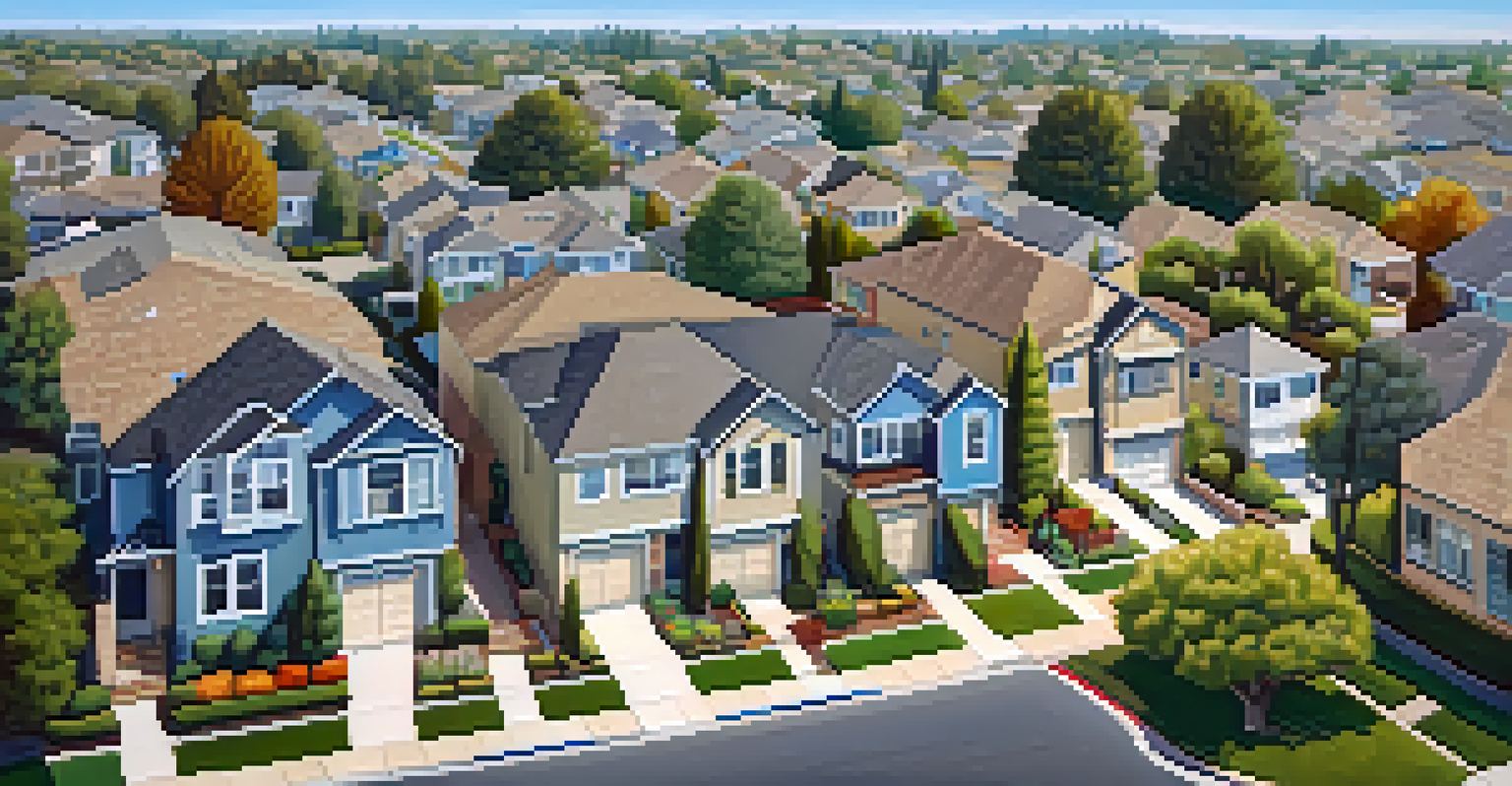Analyzing the Impact of Urban Sprawl on Sacramento Housing

Understanding Urban Sprawl in Sacramento
Urban sprawl refers to the uncontrolled expansion of urban areas into the surrounding countryside. In Sacramento, this phenomenon has been particularly noticeable over the last few decades, as more people flock to the suburbs for affordable housing and a quieter lifestyle. The shift from dense city living to sprawling suburbs has led to a transformation in the region’s landscape and community dynamics.
Urban sprawl is a symptom of our success, but it presents challenges that we must navigate carefully.
As Sacramento grows, it becomes essential to understand the implications of this sprawl on housing availability. Many residents are drawn to the suburbs for their spacious homes and green spaces, but this expansion often comes at the cost of urban infrastructure and services. Additionally, new developments can lead to the displacement of existing communities, raising questions about equity and accessibility in housing.
In summary, urban sprawl in Sacramento is a complex issue that intertwines with economic, social, and environmental factors. As we delve deeper into its impacts on housing, we’ll uncover both the benefits and challenges that come with this ongoing trend.
Housing Affordability Crisis in Sacramento
One of the most pressing issues related to urban sprawl is the affordability of housing in Sacramento. As more people move to the area, demand for housing increases, driving up prices and making it harder for many families to find affordable options. This has led to a housing crisis, where low- and middle-income families struggle to keep up with rising rents and home prices.

The sprawl often means that new developments are built in outlying areas, which can be less expensive but also farther from job centers and essential services. This creates a dilemma for residents who must choose between affordable housing and long commutes. As a result, many individuals find themselves spending a significant portion of their income on housing, limiting their ability to save or invest in other areas of life.
Urban Sprawl Affects Housing Affordability
The rapid expansion of Sacramento's suburbs has driven up housing prices, creating a crisis for low- and middle-income families.
The challenge of housing affordability in the face of urban sprawl highlights the need for comprehensive planning that considers not only where homes are built but also who can afford to live in them. Addressing this issue is crucial to ensuring a balanced and equitable housing market in Sacramento.
Impact on Local Infrastructure and Services
Urban sprawl places a significant strain on local infrastructure and services in Sacramento. As neighborhoods expand outward, essential services like public transportation, schools, and hospitals often lag behind. This can lead to longer travel times for residents and increased costs for the city to expand its services to meet the needs of a growing population.
Community engagement is not just a nice thing to do; it is essential for effective urban planning.
Moreover, the lack of adequate infrastructure can result in traffic congestion and environmental degradation. As more people rely on cars to navigate the sprawling landscape, emissions increase, contributing to pollution and climate change. This situation is particularly concerning for a city that prides itself on being environmentally conscious.
Ultimately, the impact of urban sprawl on local infrastructure must be addressed through strategic planning and investment. By prioritizing sustainable development and improving public services, Sacramento can better accommodate its growing population while preserving the quality of life for all residents.
Environmental Consequences of Urban Expansion
The environmental consequences of urban sprawl are significant and multifaceted. As Sacramento expands into natural landscapes, valuable ecosystems are disrupted, leading to loss of biodiversity. This not only affects wildlife habitats but also diminishes the natural beauty of the region, which many residents cherish.
Additionally, the increase in impervious surfaces, such as roads and parking lots, contributes to water runoff issues and can lead to flooding. Urban sprawl often results in a greater demand for water resources, putting pressure on Sacramento’s already limited supply. This emphasizes the importance of balancing development with environmental stewardship.
Infrastructure Strain from Expansion
As neighborhoods grow outward, essential services like transportation and schools often lag, leading to increased travel times and costs.
To mitigate these environmental impacts, Sacramento must consider sustainable urban planning practices. Implementing green spaces, preserving natural areas, and promoting compact development can help protect the environment while still accommodating growth.
Social Equity Implications of Housing Development
As urban sprawl continues to shape Sacramento’s housing landscape, social equity becomes a pressing concern. The expansion often favors wealthier individuals who can afford new homes in suburban areas, while lower-income families may find themselves pushed out of the market entirely. This creates a disparity in access to quality housing and essential services.
Furthermore, the development of new housing can sometimes displace long-standing communities, erasing cultural ties and support networks. The challenge is to ensure that growth does not come at the expense of inclusivity and diversity. Engaging communities in the planning process can help address these issues and foster a more equitable approach to housing.
Recognizing the social equity implications of urban sprawl is crucial for Sacramento to build a housing market that serves all residents. By prioritizing affordable housing initiatives and inclusive development practices, the city can create a more balanced and just community.
The Role of Policy in Managing Urban Growth
Policy plays a critical role in managing the impacts of urban sprawl on housing in Sacramento. Effective zoning laws and land-use policies can help guide development in a way that balances growth with sustainability. By setting clear guidelines for where and how new housing can be built, the city can better manage its expansion.
Additionally, policies that promote affordable housing and support for low-income residents are essential to addressing the housing crisis. Initiatives like inclusionary zoning, which requires developers to include affordable units in new projects, can help ensure that all residents have access to suitable housing.
Social Equity in Housing Development
Urban sprawl often sidelines lower-income families, highlighting the need for inclusive planning that ensures equitable access to housing.
Ultimately, strong and proactive policy measures are needed to navigate the complexities of urban sprawl. Sacramento has the opportunity to lead the way in creating a housing market that is not only robust but also equitable and sustainable.
Community Engagement and Future Planning
Community engagement is vital for shaping the future of Sacramento's housing landscape. Involving residents in the planning process allows for a diverse range of voices and perspectives to be heard, ensuring that development aligns with the needs and desires of the community. This collaborative approach can foster a sense of ownership and pride among residents.
Moreover, public forums, surveys, and workshops can be effective tools for gathering input and sparking dialogue about urban sprawl and housing challenges. When community members feel invested in the process, they are more likely to advocate for solutions that promote sustainability and affordability.

As Sacramento looks to the future, prioritizing community engagement will be essential in crafting housing policies that reflect the values and needs of its residents. Together, the city and its inhabitants can work towards a housing landscape that is equitable, inclusive, and resilient.